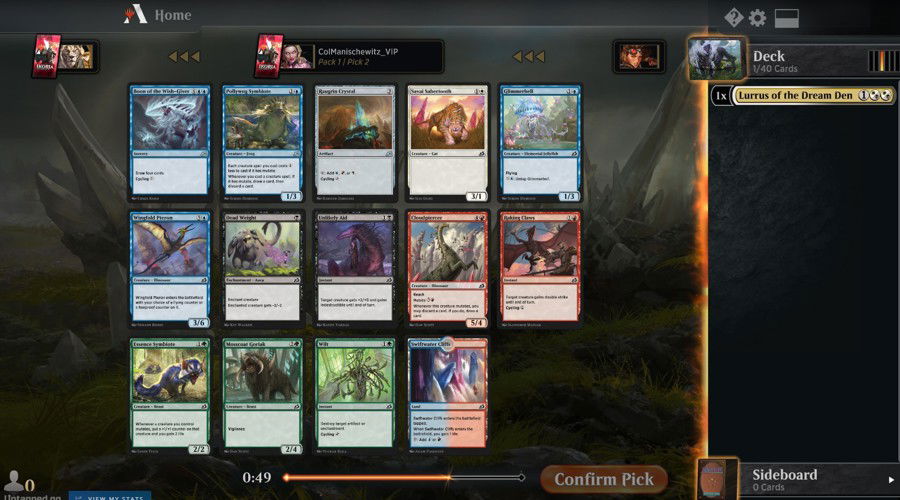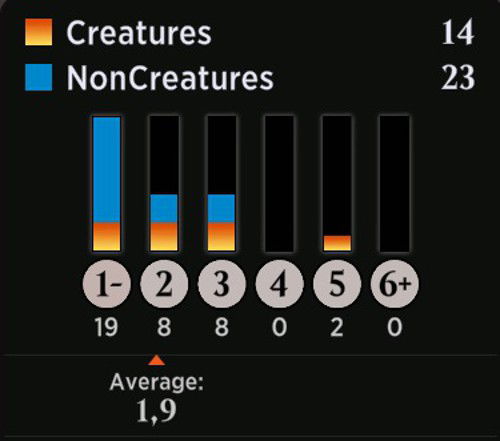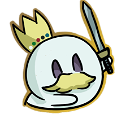Introduction
Draft is a playable format in Magic: The Gathering Arena, as well as a dynamic, challenging way to play MTG. In this two-part guide, we'll show you essential strategies that will help you build competitive decks and make smart decisions throughout your matches.
Whether you're looking for fun or just want to win, learning how to play this format will teach you a lot about MTG! Get ready to explore one of the most rewarding MTG formats around.
Full Draft Guide - For Any Set!
Magic: The Gathering charms and challenges players of all ages all around the world. It is a unique combination of strategy, deckbuilding, and creativity, so, essentially, every match is a new experience, full of new possibilities and surprises.
As for the Draft format, it stands out as one of the most exciting ways to play MTG because it is a dynamic, challenging, and extremely gratifying game experience. It will be different every time you play it, even more so because Draft features different sets at a time, and these, in turn, feature entirely different mechanics.
Introduction
If you're reading this article, then you probably heard of Draft and want to learn how to play this format in Magic: The Gathering Arena. Or maybe you've already tried playing Draft a few times, and want to be better at it, more competitive. In either case, this guide is the answer!
In this article, we'll explore essential strategies and teach you how to do better in Draft, from getting ready before the event even happens to the more advance tactics you can use during your matches. The goal is that, at the end of this article, you'll not only have a solid understanding of what Draft is, but also learn the skills necessary to stand out in this format, either in casual matches or tournaments.
Draft is one of the most challenging and rewarding formats in MTG Arena. To play it well, you need to know how to create strategies on the go, how to read the meta, analyze cards, and how to adapt to any situation. It isn't just about getting the most powerful cards, but rather how to build a deck based on the available options, and on what the other players are doing as well.
Like in any TCG, you'll need to think on your feet and make the right decisions, as well as adjust your strategy according to the situation.
1 - Pre-Game Prep
Before playing Draft in Magic: The Gathering Arena, you'll have to get ready, as this is the only to way to get as much from the experience as possible, and maximize your odds. Let's take a look at everything you need to do to get ready before your match even starts.
1.1 Understand the Format
In Draft, you're not just picking cards at random, but rather building a deck around the cards you're picking. To do this well, you need to understand how Draft works, including how sets rotate in MTG Arena, and how this could impact your choices.
Knowing the Set in Question is Critical
Each MTG set has its own mechanics and synergies, so understanding how these dynamics work in Draft is the secret to building strong decks.
Some sets focus more on combos, whereas others are more aggressive, or control. To get ready, you need to:
• Study the current set: learn which cards are available and how they interact with each other.
• Learn its mechanics: identify the main mechanics in the set, like Dungeons or Battles, and understand how they can affect your choices in Draft.
Research tools
You can use online tools to keep up with the main strategies and synergies in the set in question. A few of them are:
• CardsRealm: you can use our platform to see different decks and check out information on the format by browsing articles like this one.
• MTGGoldfish: this is a second option if you want to browse different decks and check out more information on the format.
•Draftsim: on this platform, you can train, play a few matches, and test different choices in different scenarios.
•17Lands: this platform includes data on cards, win rates, and success rates. You can also use it to track your own progress.
These platforms are valuable resources for anyone who wants to understand Draft trends, like what color combinations are popular and which cards are more efficient.
1.2 Learn Different Archetypes
When you build a deck in Draft, you'll be dealing with different archetypes, that is, strategies based around color combinations and synergies between different cards. Learning them well is often the secret to picking the best cards in any match.
Synergies and color combinations
Usually, each color combination focuses on a specific strategy (it varies in each set), for instance:
• Black and Blue (Dimir): Control and Disruption.
• Red and Green (Gruul): Aggression and Big Creatures.
• Green and White (Selesnya): Value-based Creatures and +1/+1 Synergies.
If you understand these archetypes well, then you'll know how each color combination works in Draft and how you can adapt them to your game style. Keep in mind, all of this may vary from set to set.
Popular archetypes in past sets
You can also look up what were the most popular archetypes in a particular set when it comes back into rotation again, such as:
• Eldraine (Throne of Eldraine): An archetype based around Faeries and fairy tales.
•Ikoria (Lair of Behemoths): An archetype based around beasts and abilities that modify creatures.
Understanding what these synergies are and how they work in Draft will help you make informed decisions on which cards should be your priority and which shouldn't.
1.3 How to Study for Draft
Studying the format before you play it might be the key to success. Here are a few tips on how to do it efficiently:
How to revise decks
• Look up the most efficient lists: use platforms like Untapped to research winning decks and check how the most critical cards perform in the format.

• Write down any card trends you notice: which cards are popular? How many of those are removals and how many are "impactful" cards?
Watch professional Draft content or content made by players more experienced than you.
Learning with the pros can be one of the fastest ways to elevate your skills. Look up Draft videos made by experienced players on YouTube, Twitch, or any other platforms you prefer. Pay attention to how they pick their cards and adjust their strategies.
All of this will help you get ready before you even start playing Draft. If you do all of this, you'll get the gist of the format and the available tools, which, in turn, will make you play better.
2 - Draft Strategies
Now that you're ready for Draft, it's time to see the strategies that can increase your odds when you're actually picking the cards. In Draft, constantly adapting and reading the signs is essential. Let's see the critical strategies you need to use when you start picking your cards.
2.1 First Choices
The first cards you pick are essential because they're the basis of your deck, that is, they determine which path your deck will take. You must make each decision carefully because they may be the difference between winning or losing in Draft.

Identifying premium threats and removals
• "Bombs" or "threats" are powerful cards that can win the game on their own. Typical examples include big creatures, sorceries that impact the whole board, or any very versatile card.
• Premium removals deal with the most dangerous enemy threats. In some formats, high-impact removals are as valuable as "bombs", particularly if you're controlling the match, not pushing it forward.
At first, these cards should be your priority because they can significantly impact your match. Even if they don't fit your initial strategy perfectly, a bomb, for instance, can be more useful, as it can become more flexible later on.
Flexible cards are your next priority
If you can't find a clear threat or a premium removal, get the flexible cards. These types of cards can fit different decks or be useful in many situations as you play.
Flexible cards usually are:
• Creatures with evasion (flying or trample).
• Sorceries or instants that give you value in different situations.
If you focus on flexibility and pick these cards early on, you won't have trouble adapting to the next Draft rounds.
2.2 Understanding Signs
During Draft, you need to pay attention to the "signs", that is, the subtle clues that reveal what the other players are focusing on and what they're not.
How to tell what is "open"
• Take note of what everyone is picking: if you notice players are ignoring certain colors, this may mean they're "open", and that there are still many great cards available in those colors. Making them your priority could be a great idea in this case.
• Make Consistent Choices: if you notice a certain color or strategy keeps showing up, it might be time to consider pivoting in that direction.
Adapt and take advantage of what the other players are overlooking
One of the most important skills you can learn for Draft is adapting and taking advantage of what other players are overlooking. If they're ignoring multiple great cards in a particular color, you can take advantage of this to "steal" these options.
Keep in mind that, in Draft, reading the signs and adjusting your strategy quickly is often better than following a strict game plan.
2.3 Synergy vs Raw Power
Another dilemma you'll have to face during Draft is what your priority should be: the synergy between your cards or how powerful they are, regardless of whether they match the other cards in your deck or not.
When to go for synergy
• Great synergies are critical if you're building a deck around a particular mechanic or interaction. For instance, if you're building a deck centered around sacrificing creatures, getting cards that take advantage of this interaction is crucial.
• In more complex decks, like control or midrange, the synergy between your cards is often the difference between winning and losing. By focusing on synergy, you'll be able to create a solid base with efficient strategies.
When to go for raw power
Occasionally, you might want to go for a powerful card even though it doesn't match the other synergies in your deck perfectly. That's particularly valid when the card in question can turn the game in your favor, like big bombs or powerful removals.
2.4 Mana Curve
All well-balanced decks need a great mana curve. This means adding a decent number of cards that cost different amounts of mana to make sure you always have great options throughout the match.

The best way to build aggressive and control decks
• Aggressive decks: with these decks, you want to put pressure on the opponent as fast as possible, so low-cost creatures and cards that let you attack constantly are critical.
• Control decks: with these decks, you must get cards that cost more mana, removals, and tricks to prevent your opponent from developing their game plan. Meanwhile, you'll look for your own combos or definitive answers.
Efficient mana curves
• In aggressive decks, focus on a low mana curve, that is, cards that cost from 1 to 3 mana, and add just a few cards that cost more than that.
• In control decks, a higher mana curve (with cards that cost 4 to 6 mana) is better, with more removals and control sorceries as well.
2.5 Avoid Common Mistakes
During Draft, it's easy to make mistakes and compromise your deck. Here are a few ways to avoid doing that:
Avoid focusing on niche cards too early
Cards that only work in certain scenarios or specific synergies can be tempting, but getting too many of them early on might make your deck less flexible. Try to focus on cards that fit a wide variety of decks and situations.
Avoid limiting yourself to certain colors or strategies
Don't get too attached to a certain strategy or color, particularly early on. Sometimes, the best strategy is to begin with neutral or flexible cards, and only later focus on the colors that start popping up as the Draft goes on.
If you follow the tips above, you'll have the right mindset, strategically speaking, for Draft, and will be able to make informed decisions as the cards move to your hands. Remember that flexibility and being able to read the signs are key - they are the difference between a decent Draft and a great one.
3 - Deckbuilding
After drafting, the next step is building your deck. This process is critical if you want to get the most out of the cards you picked. A well-built deck turns individual cards into a consistent force that works well together, whereas a badly built deck wastes the value of the best cards in the game.
Now, let's go through a few basic deckbuilding concepts: how to balance your mana curve, pick the best cards, and adjust your strategy.
3.1 The Ideal Deck
Before you start adding cards, you must understand the basic structure of a Draft deck:
• How many cards: in Draft, your deck must have 40 cards in total. This includes creatures, sorceries, lands, and any other card you drafted.
• Lands: the overall rule is to play between 16 and 18 lands, depending on how much mana the cards in your deck cost. Aggressive decks usually play less lands (16 to 17), while control decks or decks that play expensive cards need more (17 to 18).
• Creatures and Sorceries: most of your deck must include creatures (15 to 20), as you'll use them to attack and defend yourself. The rest of the deck can be sorceries, enchantments, artifacts, and removals. Your deck needs to have a balanced amount of these cards to work throughout the entire match.
Adjusting according to the type of deck - Aggressive, Midrange, or Control
• Aggressive decks: for aggro (aggressive) decks, your priority should be a low mana curve (1 to 3 mana). Then, focus on fast creatures that can put pressure on the opponent from very early on.
• Midrange decks: midrange decks play both expensive and cheap cards, mana-wise. They focus on controlling the board and playing efficient answers to deal with the opponent's advances, all while you set up a powerful late game.
• Control decks: control decks, on the other side, prefer controlling the game completely. These decks play a higher mana curve and focus on removals, blocks, and sorceries to answer and dominate the game until they can win with powerful cards or combos.
3.2 Mana Fixing
You won't always be able to limit yourself to a single color or simple color combinations. In some situations, you might want to use more than one color to take advantage of great cards. That's where mana fixing comes along.
When and how to splash colors
Splashing is when you include an extra color in your deck, usually to take advantage of a powerful card. If you're playing a two-color deck, you can add a card in a third color by also adding mana fixers.
Here are a few "mana fixers":
• Lands that create mana in two or three colors.
• Sorceries or enchantments that get lands in other colors for you.
• Creatures that create mana of any color.
If you decide to add a powerful card in a color that is not one of the main colors in your deck, a well-planned splash can be the key to getting ahead. But remember: if you add too many cards in a third color, it could make your deck unbalanced and inconsistent.
3.3 Sideboarding for Best-of-Threes (Bo3)
When Draft includes Best-of-Threes, you will be able to use a sideboard between matches. A sideboard lets you adjust your deck to answer your opponent's strategy.
How to add different answers for different strategies
• If you're playing against fast decks, add more removals and defensive creatures to your sideboard.
• If you're playing against control decks, add fast, threatening cards and make sure your opponent can't deal with them fast enough.
Your sideboard is a tool that will help you fix your deck's weak spots and get the best answers for specific strategies you might have to face.
3.4 Strategies to Explore Enemy Weaknesses
Knowing your deck and understanding its weaknesses is one of the best ways to get ready for the game. But you also need to explore your opponent's weaknesses.
Identifying weaknesses in the enemy deck
Take note of any signs of weakness in your opponent's deck as you draft and throughout the game:
• Not enough removals: if your opponent doesn't have many answers, your best strategy is probably focusing on big creatures or putting pressure on them constantly.
• Heavy mana curve: if your opponent is playing too many expensive cards, you can try to finish the game before they have time to use them.
You can adjust the cards you add to your deck and sideboard to explore these weaknesses. If you do it well, it can give you a decisive win.
If you follow the tips above, you'll be able to build a solid deck after drafting. You'll be able to structure your deck with the right number of lands, creatures, and sorceries, and will also be able to use mana fixers and get ready for Best-of-Threes. In the next part of this guide, we'll show you how to play your deck by applying the strategies you set up as you drafted and built your deck.
Final Words
So far, we've gone through the concepts every player needs to dominate to stand out in Draft: from understanding the format, to the cruel decisions as you pick your cards, and, finally, to building a solid, functional deck.
If you grasp these solid basic concepts, you'll be quite ahead of most beginner players. But your journey has just begun.
In the next part of the guide, we'll explore game strategies, managing rewards, and the advanced techniques that will turn your Draft experience into something even more rewarding and competitive.
I'm Rodrigo Monteiro, the Professor from ProfFriend's, and, if you read this far, thank you! What did you think of this guide? Tell us your thoughts in our comment section below.
Good luck with Draft, and see you next time!













— Comments 0
, Reactions 1
Be the first to comment